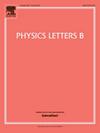Estimate of virtual photon polarization due to the intense magnetic field in Pb-Pb collisions at the LHC energies
IF 4.3
2区 物理与天体物理
Q1 ASTRONOMY & ASTROPHYSICS
引用次数: 0
Abstract
We present the first numerical calculation of the virtual photon polarization and assess the feasibility of measuring the polarization via the anisotropic decay using the LHC-ALICE detector. In presence of intense magnetic fields generated in high-energy non-central heavy-ion collisions that exceed the critical magnetic field intensity of quantum electrodynamics (QED), prompt virtual photons are predicted to decay anisotropically into lepton pairs, which we call virtual photon polarization. Using a relativistic resistive magnetohydrodynamics model, we computed the time evolution of the magnetic field and used these results to estimate the averaged polarization by calculating the vacuum polarization under the influence of the magnetic field at specific times. The estimated polarization deviates from zero with a statistical significance of 0.07σ with the data statistics collected from 2010 to 2011 and 0.15σ with the one from 2015 to 2018. It is understandable that the magnetic field could not be detected through polarization due to low statistical significance. With the data collecting the ongoing ALICE run from 2023 to 2026, the statistics dramatically increase by the upgraded LHC and the new data processing system. Thereby we expect that the statistical significance could reach , resulting in a promising probe for detecting the intense magnetic fields.
求助全文
约1分钟内获得全文
求助全文
来源期刊

Physics Letters B
物理-物理:综合
CiteScore
9.10
自引率
6.80%
发文量
647
审稿时长
3 months
期刊介绍:
Physics Letters B ensures the rapid publication of important new results in particle physics, nuclear physics and cosmology. Specialized editors are responsible for contributions in experimental nuclear physics, theoretical nuclear physics, experimental high-energy physics, theoretical high-energy physics, and astrophysics.
 求助内容:
求助内容: 应助结果提醒方式:
应助结果提醒方式:


